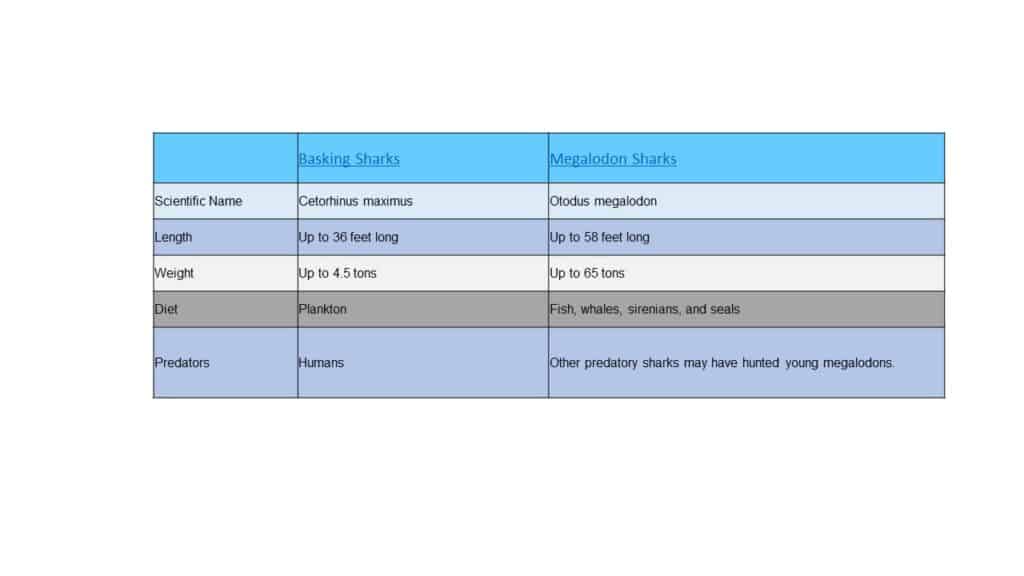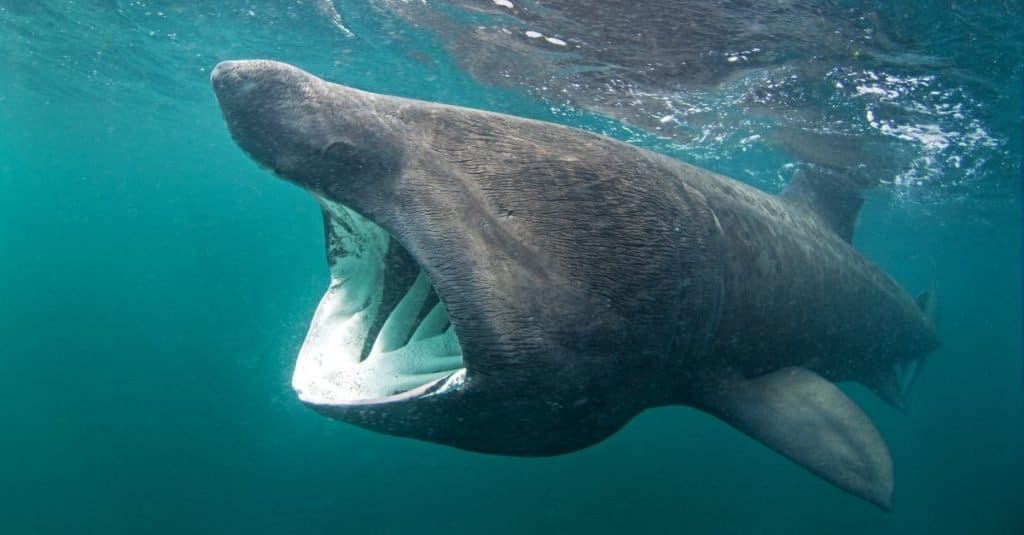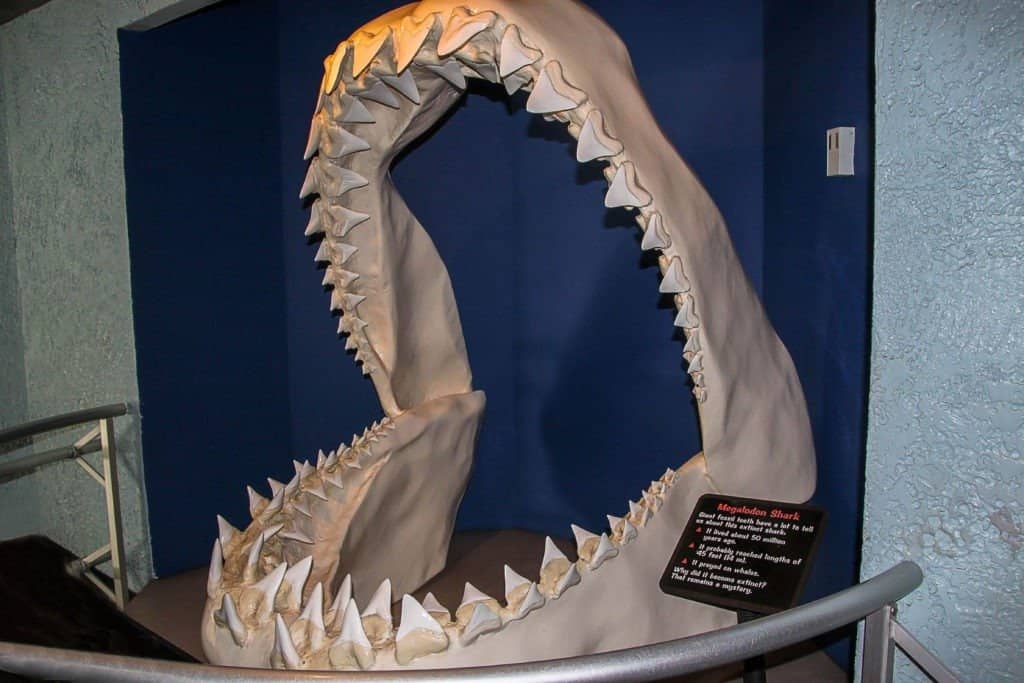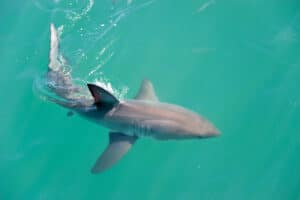The basking shark and megalodon shark are two of the largest shark species to swim in our planet’s waters. Although both these sharks are enormous, they are quite different. One still swims in our waters, while the other went extinct a few million years ago. We compare these two giants in size, behavior, diet, and more.
Basking Sharks vs. Megalodon Sharks

Basking Sharks vs. Megalodon Sharks: Size
Basking sharks are one of the largest marine animals in the ocean today, growing up to 36 feet long. These sharks are also known to weigh up to 4.3 tons. Due to their size and weight, when a basking shark carcass washes up on shore, many people have mistaken it for a mythical sea creature.
Marine biologists estimate that megalodon sharks reached lengths of bout 33.5 feet, with the most massive achieving sizes of 58 feet long. Even more remarkable is that a small number of these creatures grew to 82 feet in length. Also, research estimates that the megalodon weighed between a massive 30 and 65 metric tons. Interestingly, female megalodon sharks were longer and heavier than their male counterparts.
Basking Sharks vs. Megalodon Sharks: Behavior
Basking sharks are calm creatures and spend much of the summer season at the ocean’s surface, slowly swimming around. The shark’s name comes from their behavior as they appear to “bask” in the warm sun at the water’s surface.
These sharks generally move and live alone. But, they may occasionally swim with other basking sharks of the same sex. Still, only a handful of basking sharks tend to form a shoal.
Megalodon sharks were the opposite, being terrifying apex predators. Their size, enormous bite force, and strength made them ferocious hunters. Because of these impressive characteristics, they could hunt what they wanted, when they wanted, without fear.
Basking Sharks vs. Megalodon Sharks: Where are they found?

A basking shark, Cetorhinus maximus, swimming near Coll
Island
, Scotland. The most impressive feature of the basking shark is its mouth, which opens up to 1 meter wide.
©Martin Prochazkacz/Shutterstock.com
Basking sharks are migratory animals. You can find this species basking in the British coastal waters enjoying the summer sun during May and October. But during the winter months, this shark species migrate toward the warmer waters off the coast of North Africa. Although basking sharks are migratory animals, some choose to stay in British and Irish waters all year round.
The megalodon sharks, unlike basking sharks, lived in almost every part of the ocean. They moved freely through the vast waters, only avoiding the colder North and South Poles. Besides, young megalodon sharks seem to have preferred living near coastal areas, while adults liked the open ocean spaces. Marine biologists have also identified most of the megalodon shark fossils nearby Denmark and New Zealand.
Basking Sharks vs. Megalodon Sharks: Diet
Basking sharks are among only a few species that are planktonic feeders. When feeding, basking sharks swim with their mouths open to filter plankton. These animals also filter small crustaceans through their long, thin gill rakers. The water then exits through their gills while the food heads towards their bellies.
Megalodon sharks were the largest predators in the oceans during their time, which gave them access to a wide range of food.
For example, megalodon sharks ate toothed and baleen whales, seals, sea cows, and sea turtles.
These sharks hunted larger prey by attacking their chest area. Their powerful bites would successfully puncture their prey’s ribs, speeding up their death. Also, scientists believe that megalodons would ram and stun smaller creatures before eating them.
Basking Sharks vs. Megalodon Sharks: Reproduction
Basking sharks are solitary animals and only look for mates during the summer season. Male basking sharks reach sexual maturity between 12 to 16 years old, while female basking sharks reach sexual maturity at 20 years old.
Scientists have not yet had the luck to observe the mating practices of this shark. Still, they assume that the male will use its mouth to hold onto the female during mating. The gestation period of basking sharks is between three and three and a half years.
Scientists don’t know much about the megalodon shark’s mating and reproduction activities. Yet, they assume that they produced live offspring. Fossils of juvenile megalodon sharks provide some insight into the size of the offspring, which was roughly 6.6 feet in length. They also assume that megalodon sharks used nurseries to raise their offspring.
Basking Sharks vs. Megalodon Sharks: Bite Force
Basking sharks do not bite, so they do not have a bite force. Instead, these sharks have a wide-opening jaw that can stretch three feet wide. They use this physical advantage to capture plankton. In addition, their jaws contain several rows of minute teeth to filter their favorite meals.
Also, megalodon sharks had one of the most impressive bites ever known to science. Their jaws were roughly 9 x 11 feet wide, and they could generate a bite force of 40,000 pounds per square inch. This bite force is one of the most potent in animal history.

A fossil of a Megalodon jaw.
©Mulevich/Shutterstock.com
Basking Sharks vs. Megalodon Sharks: Predators
Basking sharks are fortunate because they don’t have many predators. But those that prey on them include humans, great white sharks, and killer whales. Humans like hunting these sharks because of their valuable fins.
Like great white sharks and killer whales, large sharks also hunt basking sharks. So, if megalodon sharks swam in our oceans today, they would likely also have been one of the basking shark’s predators.
Adult megalodons presumably had no predators besides other megalodons. But, because of their size and strength, it is possible that these creatures also preyed on each other.
It is also quite conceivable that adult megalodon sharks hunted newborn and juvenile megalodons. Likewise, other predatory sharks may have eaten young megalodons. For example, scientists estimate that great hammerhead sharks existed simultaneously as megalodons for a brief time. They speculate that hammerheads could also have hunted juvenile megalodons.
Up Next
The photo featured at the top of this post is © Chris Gotschalk / Public Domain, from Wikimedia Commons, the free media repository – License / Original
FAQs (Frequently Asked Questions)
What is the major difference between a basking shark and megalodon?
The basking shark and megalodon shark are two of the largest shark species to swim in our planet’s waters. Although both these sharks are enormous, they are quite different. One still swims in our waters, while the other went extinct a few million years ago.
Where do / did the basking shark and megalodon live<
Although basking sharks are migratory animals, some choose to stay in British and Irish waters all year round. Megalodon’ s lived everywhere, in all the oceans.
Thank you for reading! Have some feedback for us? Contact the AZ Animals editorial team.






